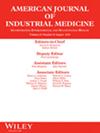Cow-Related Injuries in Wisconsin During 2017−2023
Abstract
Introduction
The dairy industry–a key industry for the economy–remains a potentially hazardous industry across the nation. The literature on animal-related injuries in the agriculture industry is sparse. This analysis aimed to describe cow-related injuries, the utilization of workers' compensation, and the circumstances of the injuries.
Methods
This mixed methods analysis of agricultural injuries focused on cow-related injuries in hospital discharge and workers' compensation data during 2017–2023. Cases, aged 12 or older, were identified in the hospital discharge data using ICD10-CM codes. Cow-related claim injury narratives and industry and occupation data were extracted from workers' compensation data.
Results
During 2017–2023, cow-related injuries represented 13.1% (n = 2659) of agricultural injuries and were the second most predominant cause of work-related agricultural injuries. These injury figures were stable, compared to a downward trend of non-cow-related injuries (p = 0.01). Young workers (12−34 years) and Hispanic workers had the highest burden for cow-related injuries. The top five body parts affected by cow injuries were the upper (24%) and lower (23%) extremities, other head, face, and neck (22.1%), chest (15.2%), and traumatic brain injury (5.1%). Workers' compensation was used in 28.5% of cases identified in the hospital discharge data. Animal handling, lack of farm worker safety measures, and equipment safety were identified as factors associated with cow-related injuries.
Conclusion
This analysis identified a surprising number of cow-related injuries, including some life-threatening injuries. It is important to continue to promote safety measures and injury prevention best-practices to ensure worker well-being and farm productivity.


 求助内容:
求助内容: 应助结果提醒方式:
应助结果提醒方式:


